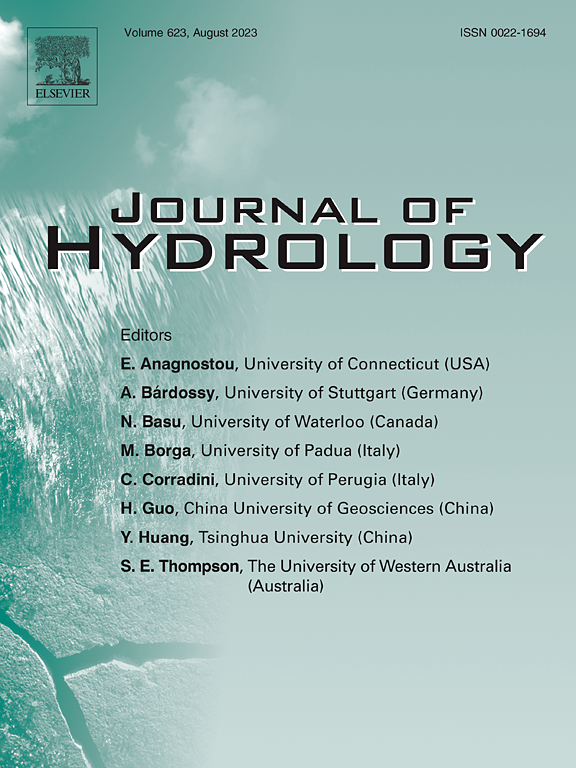TiFA: A new LSPIV Post-Processing algorithm for river surface velocity measurement under low tracer density conditions
IF 5.9
1区 地球科学
Q1 ENGINEERING, CIVIL
引用次数: 0
Abstract
The incapability of processing river surface flow velocities under low tracer density conditions is one of the limitations of the traditional Large-Scale Particle Image Velocimetry (LSPIV). This study developed a new LSPIV post-processing algorithm, Time Frequency Analysis (TiFA), to overcome such a limitation, enhance computational efficiency, and improve the accuracy of derived velocities. TiFA investigates the temporal joint distribution pattern of two velocity components at each location. By assuming that the valid velocities follow a quasi-normal distribution in the velocity time series, TiFA can quickly and accurately separate the valid velocities from background noise and outliers. The performance of TiFA was evaluated by comparing with other algorithms including Traditional LSPIV, Ensemble Correlation (EC), Large-Scale Particle Tracking Velocimetry (LSPTV), and traditional LSPIV pre-processed with Seeding Density Index (SDI) in an experimental hydraulic model and two field cases. TiFA showed the highest overall accuracy and lowest computation cost in data analysis, especially under low tracer density conditions. In addition, TiFA can automatically filter out velocity data from low-quality zones such as no-tracer zones and surface glare zones. TiFA also showed its ability in processing turbulent flow. In summary, TiFA demonstrated its great potential and competence of measuring river surface velocity under relatively low tracer density conditions, making it a valuable candidate for future applications.
TiFA:低示踪剂密度条件下河面流速测量的LSPIV后处理新算法
低示踪剂密度条件下无法处理河流表面流速是传统大尺度粒子图像测速技术的局限性之一。本研究开发了一种新的LSPIV后处理算法Time Frequency Analysis (TiFA),以克服这一限制,提高计算效率,并提高推导速度的准确性。TiFA研究了两个速度分量在每个位置的时间联合分布模式。TiFA假设有效速度在速度时间序列中服从准正态分布,可以快速准确地从背景噪声和异常值中分离出有效速度。通过对比传统LSPIV算法、集合相关(Ensemble Correlation, EC)算法、大规模粒子跟踪测速(large - large Particle Tracking velocity, LSPTV)算法和采用种子密度指数(seed Density Index, SDI)预处理的传统LSPIV算法,对TiFA算法的性能进行了评价。在低示踪剂密度条件下,TiFA在数据分析中显示出最高的总体精度和最低的计算成本。此外,TiFA还可以自动过滤掉无示踪剂区域和表面眩光区域等低质量区域的速度数据。TiFA在处理湍流方面也表现出了一定的能力。综上所述,TiFA显示了其在相对较低示踪剂密度条件下测量河流表面速度的巨大潜力和能力,使其成为未来应用的有价值的候选者。
本文章由计算机程序翻译,如有差异,请以英文原文为准。
求助全文
约1分钟内获得全文
求助全文
来源期刊

Journal of Hydrology
地学-地球科学综合
CiteScore
11.00
自引率
12.50%
发文量
1309
审稿时长
7.5 months
期刊介绍:
The Journal of Hydrology publishes original research papers and comprehensive reviews in all the subfields of the hydrological sciences including water based management and policy issues that impact on economics and society. These comprise, but are not limited to the physical, chemical, biogeochemical, stochastic and systems aspects of surface and groundwater hydrology, hydrometeorology and hydrogeology. Relevant topics incorporating the insights and methodologies of disciplines such as climatology, water resource systems, hydraulics, agrohydrology, geomorphology, soil science, instrumentation and remote sensing, civil and environmental engineering are included. Social science perspectives on hydrological problems such as resource and ecological economics, environmental sociology, psychology and behavioural science, management and policy analysis are also invited. Multi-and interdisciplinary analyses of hydrological problems are within scope. The science published in the Journal of Hydrology is relevant to catchment scales rather than exclusively to a local scale or site.
 求助内容:
求助内容: 应助结果提醒方式:
应助结果提醒方式:


